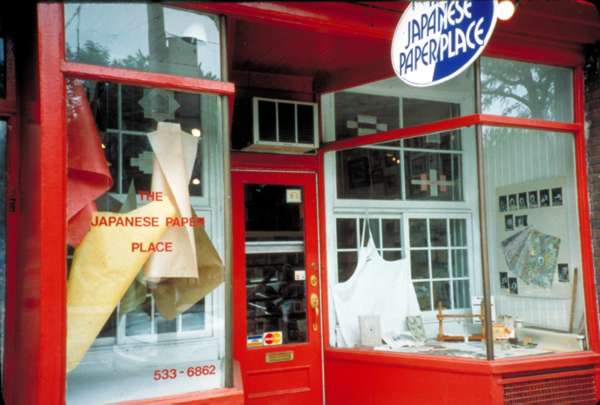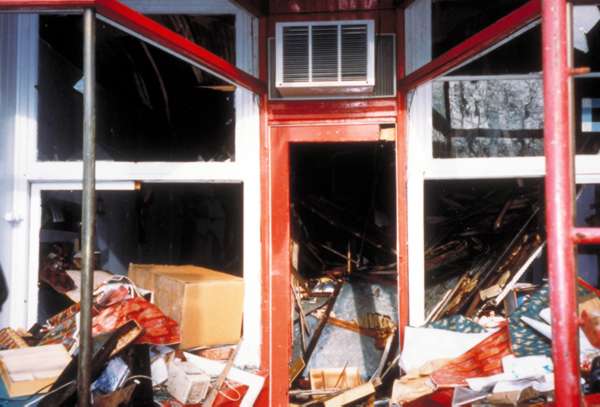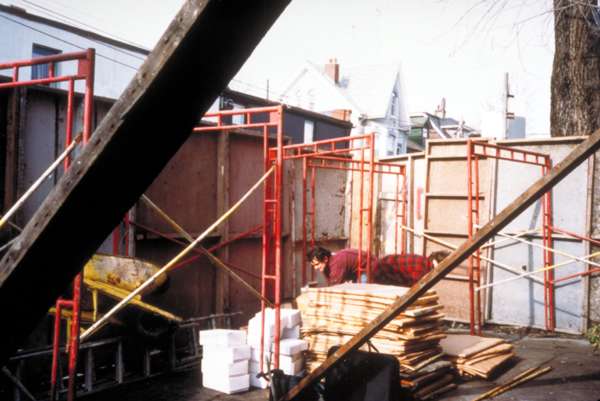Natural Freeze Drying: A Viable Option
by Betsy Palmer EldridgeIn certain regions and in certain seasons, natural freeze drying may be a viable option for response and recovery in the wake of a water involved disaster. Low tech and economical, it may be particularly appropriate for mid-sized collections that are too big to be handled by home freezers and too small to merit the involvement of the large salvage companies.
Fig. 1. The store front before the fire.
At 2 AM in the night of January 21, 1993, a fire in an adjacent building spread and burned down a store called The Japanese Paper Place in Toronto. The Japanese Paper Place, owned by Nancy Jacobi, was then–and fortunately is once again–a significant importer and retail outlet for quality handmade Japanese paper (fig. 1). After the fire, the wooden building was declared a total loss (fig. 2). However, a large part of the inventory that either had been protected from extensive fire and smoke damage by a fallen ceiling or had been stored in the basement suffered only from water damage and was thought to be salvageable (fig. 3). As soon as access to the building was permitted, the bundles of papers–most still in their original wrapping–were removed (fig. 4). While many were taken home by volunteers and air dried immediately, a large number were taken outdoors and naturally freeze dried.
Fig. 2. The store front after the fire.
In Toronto the temperature can be relied upon to stay well below the freezing mark in January. During that particular January, Toronto was experiencing an extended cold snap with the temperature consistently below 0° F. As the paper packets arrived, they were placed flat on a table outside and allowed to freeze. Two stacks several feet high gradually accumulated. A day or two later, the packets were hung over a wooden fence and left to freeze dry for several weeks. As the packets felt lighter, lost their water weight, and seemed free of blocking, they were brought inside, opened up, separated, and further air dried for a few hours to approximately 35% RH at 70° F. It was especially interesting to note that some areas in the packets that had been under plastic water proof tape preventing evaporation were still damp when brought in which gave a clear indication of the amount of freeze drying that had occurred elsewhere in the packets. As anticipated, no mold problems developed before, during or after the freeze drying.
Fig. 3. Water damaged inventory.
The project was a remarkable success. Over 10,000 sheets of fine handmade Japanese paper both plain and decorated were recovered. Particularly noteworthy were the 100% Kozo fiber papers that performed beautifully and emerged in almost perfect condition. Over a period of the next ten months, many of the irreplaceable top quality papers that still had some staining and cockling were subsequently washed, stretch dried or pressed, and brought back to a near-new state. The immediate freezing and then the subsequent natural freeze drying that occurred had stabilized and preserved a huge quantity of paper that otherwise would have been lost. In addition, it had allowed any time consuming, labor intensive further treatments to be carried out later when they could be spread out over a reasonable period of time.
Fig. 4. Salvaged bundles of paper waiting to be freeze dried.
The natural freeze drying solution is obviously limited by climate and geographic location, but when the conditions are right, it is an option worth remembering. In the case of Nancy Jacobi's Japanese Paper Place, it saved a large part of her valuable papers from certain loss with relatively little effort and at virtually no cost. However like many natural processes, it is slow and requires both patience and faith on the part of the conservator.
Betsy Palmer EldridgeIndependent Conservator, Books & Paper
Publication History
Received: Fall 1998
Paper delivered at the Book and Paper specialty group session, AIC 26th Annual Meeting, June 1-7, 1998, Arlington, Virginia.
Papers for the specialty group session are selected by committee, based on abstracts and there has been no further peer review. Papers are received by the compiler in the Fall following the meeting and the author is welcome to make revisions, minor or major.



